FNCA Timeline
compiled by Trevor, official FNCA Historian
NOTE: Words in quotation marks in the entries below are direct quotes from historic documents in our files.
NEW items added in recent months:
Year Item # Posted
2009 4 11/10
1990 8 11/7
1990 7 5/29
1985 3, 4 5/29
1983 3 5/29
1964 1, 2 text added 5/28
1932 2 5/27
1932 4 redated 5/27
1931 3 5/27
2004 1 5/24
2024 2 photo added 5/24
2024 4 + photo 5/24
1912 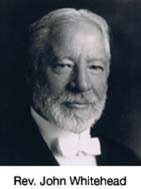 © FNCA 1925
© FNCA 1925
1. A lively correspondence about starting a "New Church summer school" occurred between Rev. John Whitehead, Rev. Herbert Small, Rev. Baman Stone, and Walter A. Robinson.
1913
1. Rev. Herbert Small leads The New England Summer School in Center Lovell ME, attended b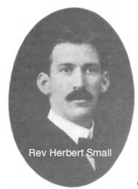 y more than 50 people. Morning and evening lectures by Rev. Julian Smyth (president of Convention), Rev. Frank Sewall of Washington DC, and Rev. Wm. Worcester (dean of the theological school). Reception held at the nearby home of Judge Job Barnard.
y more than 50 people. Morning and evening lectures by Rev. Julian Smyth (president of Convention), Rev. Frank Sewall of Washington DC, and Rev. Wm. Worcester (dean of the theological school). Reception held at the nearby home of Judge Job Barnard.
1914
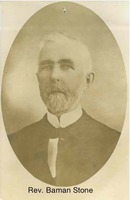 1. The New England Summer School held its second session at the Portland New Church in Portland ME, again led by Rev. Herbert Small and again attended by 50+ people. Morning and evening lectures by Rev. Julian Smyth (president of Convention), Rev. Adolph Roeder of Orange NJ, Rev. John Whitehead of Cambridge MA, Rev. Jacob Werren of the theological school, and Judge
1. The New England Summer School held its second session at the Portland New Church in Portland ME, again led by Rev. Herbert Small and again attended by 50+ people. Morning and evening lectures by Rev. Julian Smyth (president of Convention), Rev. Adolph Roeder of Orange NJ, Rev. John Whitehead of Cambridge MA, Rev. Jacob Werren of the theological school, and Judge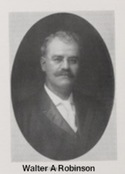 Job Barnard of Center Lovell ME. Various cultural and social outings each afternoon.
Job Barnard of Center Lovell ME. Various cultural and social outings each afternoon.
1915
1. The New England Summer School officially cancels its third session in a July issue of the Messenger.
1920
1. Rev. Louis A. Dole is on the lecture staff at Almont Summer School (now called Almont New Church Assembly) in Almont MI.
2. Rev. Louis & Anita Dole move to Fryeburg ME where, in September, Rev. Dole begins serving as the pastor of the Fryeburg New Church.
3. Rev. John Whitehead, Rev. Louis A. Dole, and Mr. Walter A. Robinson decide to start a "New Church Summer School" in Fryeburg ME the following year with Rev. Louis A. Dole as its first president.
1921
1. August 7, 1921, the first s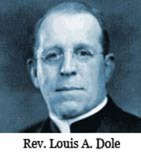 ession starts and runs for one week. Held at the Fryeburg New Church with meals at the New Church Hall (now the Fryeburg Grange Hall) and rooms in the village, with young adults tenting at Lovewell's Pond. Afternoon lectures by Rev. Wm. L. Worcester, Rev. John Whitehead, Rev. Louis A. Dole, Rev. Paul Sperry, Rev. George H. Dole.
ession starts and runs for one week. Held at the Fryeburg New Church with meals at the New Church Hall (now the Fryeburg Grange Hall) and rooms in the village, with young adults tenting at Lovewell's Pond. Afternoon lectures by Rev. Wm. L. Worcester, Rev. John Whitehead, Rev. Louis A. Dole, Rev. Paul Sperry, Rev. George H. Dole.
1922
1. Session extended to 2 weeks. Rev. Harold Gustafson and Rev. Paul Dresser added to staff.
2. Outing Day officially starts. The announcement of the session in The New-Church Messenger reads, in part: "one full day of each week will be devoted to an excursion or general outing...", hence the beginning of what was called Excursion Day through the mid-1960s or so, and which continues to this day as our weekly Outing Day on Wednesdays of each week.
1923
1. A "building fund" is started.
2. "This year was significant as marking the date of the first Summer School romance" (source: The Early History...).
3. The first known "Round River" canoe trip.
1924
1. For the first time, a possible permanent site is looked at, but deemed insufficient.
1925
1. Co-founder Walter A. Robinson passes on to the spiritual world.
1926
1. Morning chapel before the lectures is introduced.
2. From the report of the FNCA business manager, Rev. Harold R. Gustafson: "Interest has also been stimulated in the idea of purchasing a permanent site for the School. ...We feel that the Summer School is no longer an experiment and that it will be a permanent and growing institution." A second possible permanent site is looked at, but again, as in 1924, "recommended against".
1927
1. Housing and meals now held at Fryeburg Academy.
2. Committees to draw up official by-laws and to look into incorporation are created.
3. For the first time, two "young people" are "hired" to wait on tables, take care of the dining hall, and do the dishes in exchange for their board. This eventually became the standard for all teens at camp.
1928
1. On September 24, 1928, the Assembly incorporated as a non-profit, religious organization and for $650 bought 12.5 acres on the Saco River near (but not abutting) the State Line, known before then as the "Frank A. Kennett" property. Thereafter, members referred to it as "The Promised Land".
2. The young adults, still tent camping at Lovewell's Pond, one night around the campfire decide to start a camp group for the young people, calling it The Flames.
3. The first known report of what came to be known as Polar Bear Swim.
1929
1. First building: the present day Kitchen.
2. After scrambling down the bank to the river to swim the previous year, by Tuesday of the first week "we had a path and a landing."
1930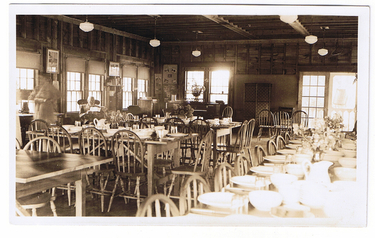 © FNCA 1930s
© FNCA 1930s
1. The current Dining Hall was built. It was referred to as the "Assembly Room" with the back half used for dining, and the front half for lectures and socializing. Lectures and Flames classes were held on the grounds; Sparks classes were held in town at the Fryeburg New Church.
2. The FNCA gets its first piano. The Fryeburg New Church parsonage in town was given a new piano so they donated the old one to the Assembly. It is extremely likely that it is the antique Square Grand Piano that we still have on the stage in Whitehead Hall.
3. First mention of an Auction at the Assembly, with Gus Bischof as auctioneer. Proceeds went to the Building Fund.
4. Co-founder Walter A. Robinson passes on to the spiritual world.
1931 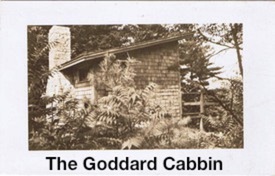 © FNCA 1930s
© FNCA 1930s
1. A "Fryeburg Carnival" was held at the Boston New Church as a fundraiser for the Assembly Building Fund, featuring classical music by the Lawrence Capon Trio, "Blue Beard" operetta in two scenes with the libretto 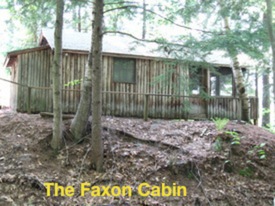 © Trevor 2011by Alice Monroe Foster, a buffet supper, dancing, group singing, a display of photos, as well as: "Side Shows, Indoor Sports, Fortune-telling, Candy and Cake Tables, Ice Cream and Punch".
© Trevor 2011by Alice Monroe Foster, a buffet supper, dancing, group singing, a display of photos, as well as: "Side Shows, Indoor Sports, Fortune-telling, Candy and Cake Tables, Ice Cream and Punch".
2. First cabin built: the Goddard Cabin, donated by Asa E. Goddard.
3. A standard daily schedule is created. "It is merely a defining of the orderly daily procedure which we have in general always followed."
4. First "young people's" class.
5. An upstairs store room is cleared out and lined with wire mesh for storage of blankets and linens becoming what is known today as the Mouse Closet.
1932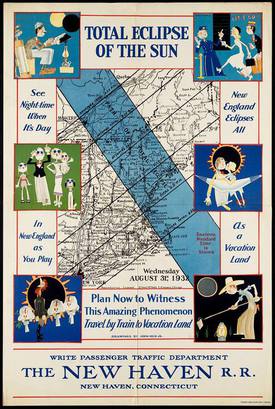
1. Third week is added to the session due to a total solar eclipse the week following the regular dates.
2. A special lecture, "The Total Eclipse of the Sun", was given beforehand by astronomer and FNCA vice president Asa E. Goddard.
3. From the Summer issue of the New-Church League Journal: "At least one tennis court will be ready for use this summer. ... [W]e have ten new dining-tables, a full outfit of new table silver, a fire-screen, andirons and fire-set, screen doors, and a reading lamp — all gifts of friends of the Assembly."
4. First known meeting (quite possibly not the first) of the "Ladies of the Assembly" or "The Women's Alliance", a gathering of all the women at camp to raise money to help fund the FNCA. First president: Mrs. Asa Goddard.
5. Thanks are sent by FNCA Secretary, Anita Dole, to Lloyd Frost at the New Church Theological School in Cambridge MA for "giving us the use of the Victrola belonging to the Theological School. It was much needed and is greatly appreciated by all."
1933
1. First known record of women on the lecture staff, with lectures by Miss Elizabeth Beaman and Miss Lilybell Bates.
1934
1. First known record of the Sales Table.
1935
1. What came to be known as the Faxon Nature Trail is "cut along the river bank the length of the Assembly grounds."
2. From the bulletin: "The Assembly is pleased to offer a series of lectures this year on "Music of the Church" by Mr. Horace B. Blackmer, organist of the New Church in Boston. His lectures will be illustrated at the piano and interspersed with singing."
3. From The New-Church Messenger, September 18, 1935: "Note: A movie film of two reels, part in color, taking thirty minutes, showing all the activities of this 1935 Assembly — lectures, ministers, attendants, classes, sports, and the buildings and scenery — will be available after October 15th for advertising the Assembly. A 16-mm. projector is necessary. Apply for dates to F. W. Faxon, Roslindale, Massachusetts."
1936
1. The second cabin is built: the Faxon Cabin, donated by Fred W. Faxon.
2. A "Committee to keep the Summer-House" (now the Main Building) is created. It would eventually become today's Buildings & Grounds Committee.
3. The Twitchell Memorial Fund — named for Miss Frances Twitchell, the FNCA's first treasurer who died before this year's session — is initiated to "to reduce the indebtedness of the Assembly."
4. From the bulletin: "During the third week... a special course of training for teaching in New-Church Sunday Schools will be conducted under the joint auspices of the Assembly and the American New-Church Sunday School Association." This continued for several years, at least until 1940.
1937
1. The Ladies of the Assembly officially changed their name to "The Women's Auxiliary of the Fryeburg New-Church Assembly".
1939
1. The third cabin is built (of Oregon fir): the Bellows Cabin, donated by Mary A. Bellows.
1940
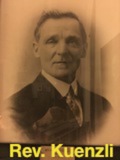 © Rev. Susannah Currie 20171. After 20 years, Rev. Louis A. Dole steps down, with Rev. Charles H. Kuenzli becoming the second FNCA president.
© Rev. Susannah Currie 20171. After 20 years, Rev. Louis A. Dole steps down, with Rev. Charles H. Kuenzli becoming the second FNCA president.
2. Chalmers' Lodge is built, donated by Jeanette F. Chalmers in honor of her late daughter Elizabeth "Bette" Chalmers.
3. The Claxton Cabin is built, donated by Helen C. Claxton.
1941
1. The Women's Auxiliary was given an American flag that had belonged to Rev. & Mrs. John Whitehead by their three daughters, and discussion begins on funding a flagpole. (The pole was finally put up in 1950.)
2. Hurricane devastation of the trees made it financially possible to buy the land between the original property line and the State Line, approximately another 9 acres, bringing our total acreage up to just shy of 21 acres.
1942-1945
1. The Assembly did not meet because of World War II.
1946
1. Rev. Kuenzli having passed on, Rev. Louis A. Dole agrees to be president for one more year.
2. Brand new Navy surplus tents are purchased that are "far better than those previously used, in that they are fire resistant and insect proof".
1947
1. "City electricity" reaches the Assembly; the Main Building is rewired and the old gas-powered electricity generator is sold; the old coal stove is sold and 2 electric stoves are installed in the Kitchen.
2. Mr. F. Gardiner Perry becomes the third FNCA president.
1948
1. President F. Gardiner Perry requests table space at Convention for "an exhibit of the Fryeburg Assembly."
2. Before the session, the Taft Cabin is built (of seasoned white pine), donated by Charles and Emily Taft in honor of their late daughter, Emily Taft. Its first resident for all three weeks: Florence Murdoch who invited fellow artist Florence Whitehead to share the cabin with her.
1949 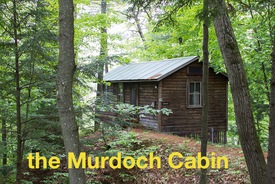 © Jon Cousins 2013
© Jon Cousins 2013
1. The Murdoch Cabin is built, donated by artist Florence Murdoch. It is still known as "the artist's cabin" today.
1950
1. The 25th session of the FNCA received much attention as an "Anniversary Session" with reunions of the "young people" as well as many "old timers" attending after many years of absence.
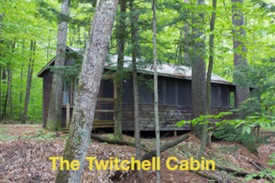 © Jon Cousins 20132. The Twitchell Cabin is built in honor of Frances Twitchell, the Assembly's first treasurer who, as recording secretary, was one of the original signers of the Assembly's constitution in 1928.
© Jon Cousins 20132. The Twitchell Cabin is built in honor of Frances Twitchell, the Assembly's first treasurer who, as recording secretary, was one of the original signers of the Assembly's constitution in 1928.
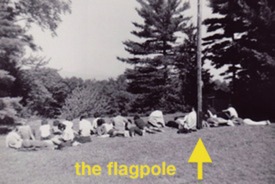 © FNCA 19623. Using money from the Women's Auxiliary, a wooden flagpole made from a tree grown on the Assembly property was erected on the upper lawn at the center of the top of the hill, and the American flag donated in 1941 was (finally!) raised at the Assembly for the first time on August 13, 1950 at 8:00 in the morning.
© FNCA 19623. Using money from the Women's Auxiliary, a wooden flagpole made from a tree grown on the Assembly property was erected on the upper lawn at the center of the top of the hill, and the American flag donated in 1941 was (finally!) raised at the Assembly for the first time on August 13, 1950 at 8:00 in the morning.
1951
1. Mrs. Asa Goddard donates funds to enlarge the porch of the Goddard Cabin, roof it over, and screen it in.
2. A fenced-in play yard for the children was built in the grove of trees between the Main Building and the boys' tent (near where the end of Whitehead Hall is now).
3. Previously always at the Fryeburg New Church, Sunday evening Vespers is held at the Assembly for the first time
1952
1. The first Sales Table Auction is held.
2. Rev. William R. Woofenden first elected to the Board.
1953
1. The FNCA gets its first laundry machine, a Bendix Washer.
2. A wooden tent platform is built near the Faxon Cabin for a new tent to house just the "little boys", who up until now had been sleeping in a tent with the teen and college-age boys; hence, the beginning of the Little Boys Tent which was where the cement slab with the clotheslines is currently next to the Mack Cabin.
3. The Assembly pays off "the only outstanding mortgage on the present buildings".
4. A spotlight is installed on the ceiling of the fireplace end of the Dining Hall to light the lecturn for the lecturers and preachers.
1954
1. The lectures are tape recorded (possibly for the first time) and copies made available by the "young and energetic" Rev. Wm. Woofenden.
2. Leonora "Orah" Hutchins Bray, wife of Rev. Everett K. Bray, dies at camp on August 23. $500 is collected to build a double cabin in her honor.
3. From the report of the Trustees at the Annual Meeting: "Speed limit signs have been placed. Parking space signs and road signs indicating "SLOW — HIDDEN DRIVE 500 FEET" to protect the Assembly entrance road have been approved and will be installed."
4. The Swedenborg Foundation donates a full set of the Standard Edition of the Writings.
1955
1. The Fryeburg New Church in town sold the New Church Hall (where the Assembly's lectures and meals were held in our earliest years) to the Fryeburg Grange. It's been the Fryeburg Grange Hall ever since. 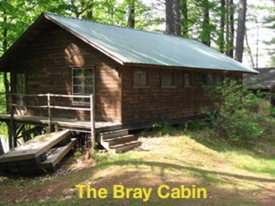 © Trevor 2011
© Trevor 2011
2. Before the camp session, the Bray Cabin was built in memory of Leonora "Orah" Hutchins Bray who died at camp during the Assembly session the previous year. Her husband, Rev. Everett K. Bray, was a core lecturer at the Assembly from the 1930s through the 1960s.
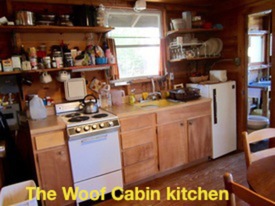 © Nancy F. Little 20163. Also before the camp session, the Woofenden Cabin is built, donated by Rev. William R. and Louise Dole Woofenden. It is the first cabin to have a kitchen and electric heat (instead of a woodstove like all the other cabins had at the time), and is the only cabin built without a porch or a deck.
© Nancy F. Little 20163. Also before the camp session, the Woofenden Cabin is built, donated by Rev. William R. and Louise Dole Woofenden. It is the first cabin to have a kitchen and electric heat (instead of a woodstove like all the other cabins had at the time), and is the only cabin built without a porch or a deck.
1956
1. Adult Bible Study class is held at the same time as the young people's classes three times each week.
1959 (or perhaps in the Fall of 1958)
1. The Goddard Annex is built with a children's playroom and the back kitchen on the first floor, and the teen Girls Dorm on the second.
1960
1. Sunday School Teacher trainings are, once again (see 1936), a part of the Assembly program.
2. After camp in October, the Women's Auxiliary publishes a request for donations to next year's Sales Table, in part, to help "pay for a modern dishwasher for 1961."
3. "Mr. John C. Perry, member of the Mountain Leadership Committee of the Appalachian Mountain Club will show a film of climbing in the White Mountans, and will give instruction in mountain leadership to the young people who are there." This program was offered for the next several years, at least until 1965.
1961
1. The FNCA rules and daily schedule are first posted in each room of the camp.
1962
1. The Mack Cabin is built, donated by Gwynne Dresser Mack and the entire Mack family in honor of her mother-in-law, Mrs. Laura Mack, as a dressing room for the Big & Little Boys, with the Big Boys Tent at one end and the Little Boys Tent at the other.
2. The Assembly gets it's first phone.
1963
1. An article titled "A Brief History of the FNCA" by Mrs. Anita S. Dole, covering 1914-1968, is published in the July 1963 issue of The Maine Newchurchman magazine.
2. "A large new cooking stove was installed and many donations helped pay for it."
3. The Assembly gets its first phone.
4. "A two hour concert was given by Jose Melis of the Jack Paar Show with Jose's son Michael on drums, and Ray and his wife Betty performing Cuban dances. Members of the Woofenden and Dole families also played and sang."
Jose Melis was the younger brother of long-time FNCA 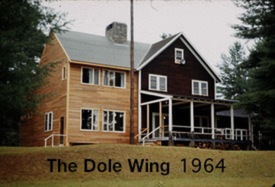 © Rev. George F. Dole 1964member Ray Guiu who emigrated to the USA from Cuba. His wife Betty was the daughter of the Rev. Everett K. Bray, a core lecturer at the Assembly from the 1930s through the 1960s.
© Rev. George F. Dole 1964member Ray Guiu who emigrated to the USA from Cuba. His wife Betty was the daughter of the Rev. Everett K. Bray, a core lecturer at the Assembly from the 1930s through the 1960s.
5. Mrs. Pauline Lawrence announces at camp her family's intention to build a cabin in honor of her late husband, Arthur. The Lawrence Cabin is built in the Fall after the camp session and is the eleventh cabin.
6. The Executive Committee appoints the first ever Nominating Committee for the following year's elections.
7. A week of special training sessions for Sunday School teachers are held once again (see 1936 and 1960).
1964
1. Co-founder Rev. Louis A. Dole passes on to the spiritual world in February. A memorial service is held for him to a capacity crowd at the Fryeburg New Church in town the first Sunday of camp.
2. The Dole Wing is built in honor of Rev. Louis A. and 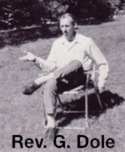 © FNCA 1962Anita S. Dole. Rev. Dole was one of the FNCA's original founders, our first president, and both a core lecturer and an FNCA officer from our inception in 1921 until his death. Anita S. Dole, who wrote the Dole Bible Study Notes, was a young people's religion class teacher nearly all that time, too. A dedication ceremony is held the evening of that same first Sunday of camp, ending with a ceremonial lighting of the first fire in the Dole Wing fireplace (which had been covered up outdoors since the Dining Hall was built in 1930). "The lighted match was placied in the logs by the Rev. Louis A. Dole's grandson, Stuart Dole."
© FNCA 1962Anita S. Dole. Rev. Dole was one of the FNCA's original founders, our first president, and both a core lecturer and an FNCA officer from our inception in 1921 until his death. Anita S. Dole, who wrote the Dole Bible Study Notes, was a young people's religion class teacher nearly all that time, too. A dedication ceremony is held the evening of that same first Sunday of camp, ending with a ceremonial lighting of the first fire in the Dole Wing fireplace (which had been covered up outdoors since the Dining Hall was built in 1930). "The lighted match was placied in the logs by the Rev. Louis A. Dole's grandson, Stuart Dole."
3. Their son, Rev. Dr. George F. Dole, becomes the fourth FNCA president.
4. The Assembly voted at the Annual Meeting to amend the constitution to provide for a continuing Nominating Committee.
1965
1. "The Dole Wing is furnished beautifully by the family of Mrs. Hazel Baker Clark as a memorial to her and part of their contribution to that wing."
2. "A considerable amount of timber has been cut and sold, under the direction of the Trustees and with the expert advice of a Maine Forester... making a substantial contribution to the cost of the Dole Wing...."
3. On a recommendation from the Trustees, the Executive Committee voted to form a 5-member Finance Committee.
4. Officers of the Oriental Society of the New Church attended the final weekend, giving reports on the New Church in Taiwan and the New Church in Hong Kong, as well as preparing a delicious Chinese dinner.
1967
1. Leadship Education Institute (LEI), a Convention program for young adults, meets at the Assembly the week before camp starts.
1968
1. The Perry Wing, donated by Mr. & Mrs. F. Gardiner Perry, is built off the back of the  © Trevor 2011Main Building, with two rooms to house people who have trouble climbing stairs.
© Trevor 2011Main Building, with two rooms to house people who have trouble climbing stairs.
1971
1. It's the Fryeburg New Church Assembly's 50th anniversary! A full weekend of events drew lots of people who hadn't attended for years to the celebration.
1972 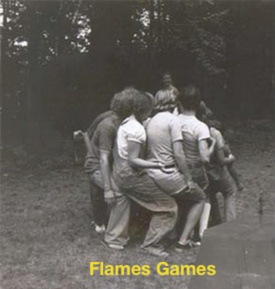 © FNCA 1973
© FNCA 1973
1. A new play yard is fenced in behind the Goddard Annex and a door and steps put in to access it.
2. Flames Games started by Trevor.
3. The Trustees announce their intention to "replace all the plumbing and pipes in the entire system."
1975
1. The lecture hall is built. (35 years later, in 2010, it is named "Rev. John Whitehead Lecture Hall" after one of our Original Founders.)
2. This year, after being filed continuously since 1935, the minutes of the Women's Auxiliary of the Fryeburg New Church suddenly stop, with this years' being the last. Yet the Women's Auxiliary continues to run the Sales Table for 5-10 more years.
1976 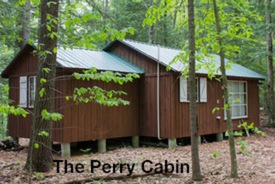 © Jon Cousins 2013
© Jon Cousins 2013
1. The Perry Cabin and the Bath House are built, donated by life-long members Fred & Nancy Perry.
1978
1. The Flames 50th Anniversary Celebration with attendance of about 120 people.
2. Sparks Games start on a suggestion from Rev. Dr. George F. Dole.
1979
1. For the first time, a tri-fold brochure is made containing basic camp information as well as a map of the Assembly.
1982
1. The third week of camp is dropped, bringing it back to two weeks, the way it was from 1922-1931.
1983
1. A large dinner bell is 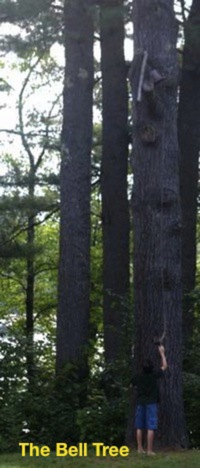 © Beki Greenwood 2009bought in Pennsylvania by the Rev. Dr. & Mrs. Wm. R. Woofenden and donated to the Assembly. It is braced into a fork of a tall pine tree at the edge of the lower lawn. Before this, program events were signaled by a runner with a handbell circling the entire camp for warning bells and the starting bells throughout the day.
© Beki Greenwood 2009bought in Pennsylvania by the Rev. Dr. & Mrs. Wm. R. Woofenden and donated to the Assembly. It is braced into a fork of a tall pine tree at the edge of the lower lawn. Before this, program events were signaled by a runner with a handbell circling the entire camp for warning bells and the starting bells throughout the day.
2. A drawing is held at Convention for a free week at camp for two. This is done for a few more years.
3. A new meals work system: all campers, not just Flames, are divided into teams and took turns with kitchen and dining hall duties.
1984
1. Several acres of FNCA property at the northeast end of camp (beyond the current Boys Bunkhouse) are sold. A 1/2 acre sliver is sold to our neighbor, the Eastmans, at their request "to straighten their property line". The rest is bought by long-time FNCA members Ed & Wendy Schnurr.
2. The proceeds from the above sales are used to purchase three lots from the Weston Way housing development at the opposite end of camp in New Hampshire because they were uncomfortably close to the Perry Cabin and we didn't want permanent residences that close to camp.
3. The retrospective column "Reflections", about the previous year at camp, starts in the FNCA Bulletin.
4. An open-to-the-public homeopathy lecture was given by Dr. Richard Moskowitz, MD. It was quite well attended by campers, Fryeburg New Church members, and several other local people.
5. Four artists at camp arrange a two-day "Artists' Excursion" during camp into the White Mountains to paint and sketch. A similar trip is planned for the following year.
1985
1. From the Bulletin: "...this summer on August 11, we will have Open House to the public from 2:00-4:00 p.m. (cabins neat and tidy, please!) Refreshments will be served."
2. Professional naturalist and long-time FNCA attendee, 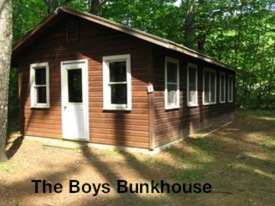 © Trevor 2011Anne Perry, is on staff, doing a program on nature study second week.
© Trevor 2011Anne Perry, is on staff, doing a program on nature study second week.
3. Special guest lecturers, Bill Lord and his wife Fonchen, "offer a series of talks and working groups on Dreams."
4. Following an organ recital at the Fryeburg New Church in town, renowned organist and Portland ME resident, Douglas Rafter, presents a special lecture at the Assembly on church music.
1986
1. Through the efforts of long-time FNCA treasurer, Alice F. Vigerstad of Orange NJ, the Assembly gets a substantial gift of $20,000 from the Orange Society on their "painful decision to disband."
1987
1. The week before camp, an artist retreat is held, "Landscape Painting in the White Mountains", hosted by FNCA artist Carolyn Judson with 3 hours of instruction each day by Brooklyn artist Jacqueline Lima.
2. The Little Boys Tent and the Little Girls Dorm are discontinued, so all children under 13 are housed with their parents or guardian starting this year.
3. An experiment is tried Second Week: just having one lecture a day with the second lecture period "given over to discussion of the lecture in smaller groups."
1988
1. The Boston Cabin is built, donated by the Boston Society of the New Jerusalem.
2. The Boys Bunkhouse is built on the concrete slab of the old Big Boys Tent.
3. A post-Convention R & R is held at the Assembly from July 3-6.
1989
1. Rev. Jim Lawrence becomes the next FNCA president.
1990 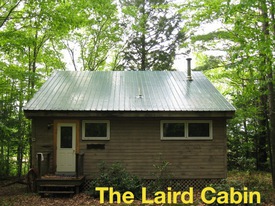 © Trevor 2013
© Trevor 2013
1. The Laird Cabin is built and dedicated, donated by Ron & Dorothy Davies in honor of their late son Laird Davies.
2. The first Work Weekend is held.
3. Louise Dole Woofenden, daughter of one of our original founders, Rev. Louis 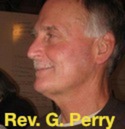 © Trevor 2013A. Dole, is appointed Camp Historian by the Executive Committee (now the Board of Trustees).
© Trevor 2013A. Dole, is appointed Camp Historian by the Executive Committee (now the Board of Trustees).
4. Rev. Gard Perry, grandson of the third FNCA president, becomes the next FNCA president.
5. The first Alice F. Vigerstad Memorial Old Lady Canoe Trip is a huge success and is repeated 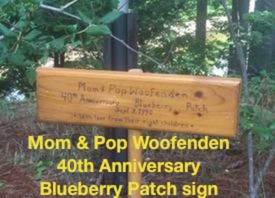 © Ian Woofenden 2016the following year and nearly every year since.
© Ian Woofenden 2016the following year and nearly every year since.
6. The eight Woofenden siblings present the Assembly with 8 highbush blueberry bushes in honor of their parent's 40th wedding anniversary. These are planted in the far corner of the lower lawn.
7. The FNCA Feasibility Study Committee submits a report about outside use of the Assembly grounds.
8. The deck on Whitehead Hall is completely rebuilt.
1992
1. Major discussion at the Annual Meeting about switching from having both an Executive Committee and a Trustees committee to a single Board of Directors, with various committees all under their umbrella. It is the first formal discussion with the members about this idea. This change was implemented 10 years later in 2002.
1994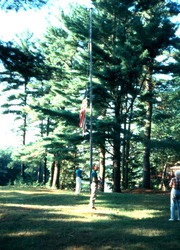 © FNCA 1994
© FNCA 1994
1. The Assembly gets a new American flag, donated by assistant cook Cindy Bouffard's husband, from his father's military funeral.
1995
1. Ellen Morin, daughter of former FNCA president Rev. Dr. Wm. R. (& Louise Dole) Woofenden and granddaughter of FNCA founder Rev. Louis A. (& Anita S.) Dole, becomes the 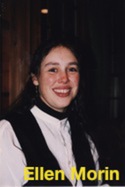 © FNCA 1996next FNCA president.
© FNCA 1996next FNCA president.
2. The idea of what is now called the Outreach Committee is first suggested in an Executive Committee Meeting.
1998 (or maybe 1997)
1. The Tool Shed is moved from near the end of the Goddard Annex to next to Chalmers Lodge.
1999
1. On January 25, the FNCA's first website goes public.
2. Much to our surprise, most of the trees lining the far side the river are cut down, opening up our views of the mountains and the plains before them that haven't been seen from groundlevel for 3 or 4 decades.
3. The old wooden flagpole at the top of the front lawn hill is taken down, and a new metal flagpole is put up in the far downstream corner of the front lawn.
2000
1. Lalla Searle, with a crew of relatives, begins a planting project putting in flowers and bushes that bloom in August and (in her words) "can suffer benign neglect the rest of the year" in front of various cabins and in the ravine between the front lawn and the Claxton Cabin.
2. A special Sunday dinner is held the final weekend celebrating the 50th wedding anniversary of Rev. Dr. William R. & Louise Dole Woofenden.
2001 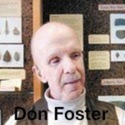
1. Don Foster becomes the next FNCA president.
2002
1. At their mid-winter meeting, the Executive Committee approves a much-needed update of the FNCA's administrative structure to be more in line with current standards for non-profit organizations: separating policy making from program running, with an elected Board of Directors in charge of the former as well as all committees, and a mostly ex officio Summer Session Committee in charge of the latter, with the Camp Director also being elected by the membership. This proposal is approved by the membership at the Annual Meeting.
2003
1. Adrienne Frank Fellowship Hall is built before camp starts with fund donated by Mrs. Adrienne Frank.
2. The president, vice president, secretary, and treasurer resign from the newly-formed Board of Directors in July, a few weeks before camp starts.
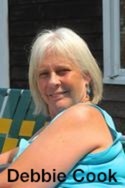 © Beki Greenwood 20143. Debbie Cook immediately steps in as Camp Director and is officially elected to that position at the Annual Meeting. John Perry steps up as chairman of the Board. And other volunteers immediately step into the other vacated positions pro tem and camp runs without a hitch.
© Beki Greenwood 20143. Debbie Cook immediately steps in as Camp Director and is officially elected to that position at the Annual Meeting. John Perry steps up as chairman of the Board. And other volunteers immediately step into the other vacated positions pro tem and camp runs without a hitch.
4. The Flames 75th Anniversary celebration is very well attended with old Flames attending from more than a dozen states.
5. The original website is closed down and a new website begins.
2004
1. For the first time in many, many decades, the camp session does not start on the first Saturday in August because many schools have started beginning their school year in mid-August, before camp traditionally would end.
2. Trevor, grandson of one of our original founders, Rev. Louis A. Dole, "inherits" the position of Camp Historian from his mother, Louise Dole Woofenden. 6 or 7 years later, he is officially appointed to this position by the chair of the Board of Trustees.
2008 
1. Ken Turley becomes the next FNCA President.
2. Deane Currie is elected Camp Director.
3. At Deane's request, we have our first Tie Dye Day where everyone who has one wears a tie dyed shirt.
4. The State of Maine builds a brand new Maine Visitors Center at a new location directly across the street from the Bunkhouse.
2009 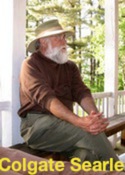 © Beki Greenwood 2010
© Beki Greenwood 2010
1. Debbie Cook re-elected Camp Director.
2. Colgate Searle II becomes the next FNCA president.
3. The 18-22 year old campers enthusiastically accept a proposal to be classified as "Senior Flames" with all the privileges of adults but participating in the Flames program and paying Flames' rates, too.
4. FNCA Facebook page begins on August 24.
2010
1. This website, fryeburg.org, goes live on June 10th, becoming the FNCA's 3rd official website.
2. The Opening Weekend Program starts.
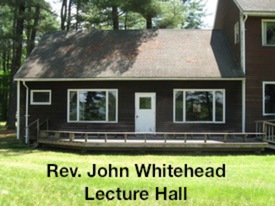 © Trevor 20113. At the Annual Meeting, the membership votes to name the lecture hall, built in 1975, for one of our unsung original founders. It is now called the Rev. John Whitehead Lecture Hall, Whitehead Lecture Hall or simply Whitehead Hall.
© Trevor 20113. At the Annual Meeting, the membership votes to name the lecture hall, built in 1975, for one of our unsung original founders. It is now called the Rev. John Whitehead Lecture Hall, Whitehead Lecture Hall or simply Whitehead Hall.
2011 1. Jason Greenwood is 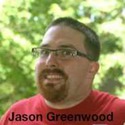 © Beki Greenwood 2013elected Camp Director.
© Beki Greenwood 2013elected Camp Director.
2. After operating informally for 2 or 3 years, the FNCA Outreach Committee submits a formal proposal to become an official committee of the Assembly. The Board votes favorably on the proposal.
3. A new hallway is created on the 2nd floor of the Main Building between the upstairs bedrooms and the Girls Dorm.
4. The Afternoon Book Club begins.
2012
1. The first annual LALLA 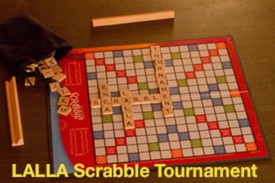 © Jon Cousins 2013Searle Memorial Scrabble Tournament is held, with the finals held at a special party
© Jon Cousins 2013Searle Memorial Scrabble Tournament is held, with the finals held at a special party
in Frank Hall.
2014
1. The first annual Rev. Dr. George F. Dole Celebration Three Mile Road Race (a.k.a. The Dole 3 Miler) is held on the 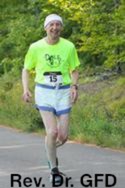 © Jon Cousins 2014Mountain Division Trail which begins at the Maine Visitor Center directly across the street from the Assembly.
© Jon Cousins 2014Mountain Division Trail which begins at the Maine Visitor Center directly across the street from the Assembly.
2015
1. Rev. Everett K. Bray Visiting Lecturer program is initiated.
2. The Summer Session Committee (with full approval of the Board) decides to discontinue the camp Bulletin since it is no longer really needed because all the necessary information it contained is now online.
2016
1. For the first time, on the final Saturday of camp, our lectures are live streamed on the FNCA Facebook page with more than 400 live "views" between the two of them. We have truly expanded our outreach!
2019
1. As part of a major upgrade of Rte 302, the State of Maine takes a narrow strip of land along the edge of the road the full length of our property by eminent domain, and cuts down the trees on it, including nearly all the ones between the back field and Rte 302.
2020
1. In May, the Board of Directors votes to cancel the physical camp session due to a world pandemic, and instead hold a virtual camp session in August and appoints an ad hoc Virtual Summer Session Committee.
2. By virtue of being the chair of the Virtual Summer Session Committee, lifelong member and grandson of original co-founder Rev. Louis A. Dole, Trevor becomes the de facto Camp Director for the 2020 session.
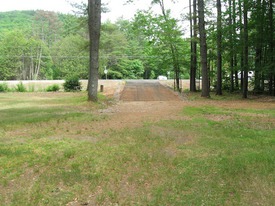 © Trevor 20203. The State of Maine, after first replacing our entrance (due to 2019:1 above) with a way too steep and narrow driveway last Fall, re-replaces it with a wider, longer, much more gradually inclined driveway.
© Trevor 20203. The State of Maine, after first replacing our entrance (due to 2019:1 above) with a way too steep and narrow driveway last Fall, re-replaces it with a wider, longer, much more gradually inclined driveway.
4. Alia Woofenden, great granddaughter-in-law of founder Rev. Louis A. Dole elected Camp Director.
2021
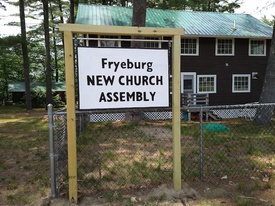 © Jon Crowe 20211. For personal reasons, the new Camp Director steps down in early Spring. The Summer Session Committee steps up and and agrees to act together as camp director for the session.
© Jon Crowe 20211. For personal reasons, the new Camp Director steps down in early Spring. The Summer Session Committee steps up and and agrees to act together as camp director for the session.
2. With special events spread throughout the entire session and daily "Centennial Moments" about the past 100 years  © Beki Greenwood 2021of camp history, the 2021 session is a gala Centennial Celebration complete with a birthday party and birthday cake on August 7, 2021, exactly 100 years from the first day of the first session in 1921!
© Beki Greenwood 2021of camp history, the 2021 session is a gala Centennial Celebration complete with a birthday party and birthday cake on August 7, 2021, exactly 100 years from the first day of the first session in 1921!
3. A permanent FNCA sign facing the road is installed in front of the play area by the 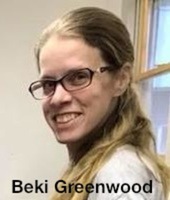 © Nancy F. Little 2018Goddard Annex.
© Nancy F. Little 2018Goddard Annex.
4. The old Boys Dorm is repurposed as the new art cabin and dubbed The Treehouse.
5. Beki Greenwood is elected Camp Director and Dan Dyer becomes the new Board President.
2022
1. Two year's after it was donated, the "Lalla's Garden" quilt raffle drawing is 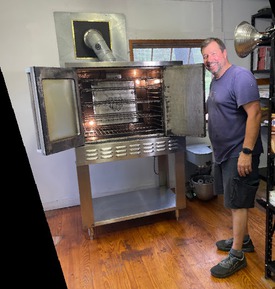 © Emily Woofenden 2022held at the 2022 Annual Meeting, with Fryeburg's own Lee Dyer the winner!
© Emily Woofenden 2022held at the 2022 Annual Meeting, with Fryeburg's own Lee Dyer the winner!
2. The Kitchen gets a new convection oven.
3. After camp, a new split rail fence is put up along the roadside of the back field to re-establish our boundry from when the State took down all the trees in 2019.
2023
1. The first planting of "Lalla's Garden" in August right after camp.
2024
1. A brand-new Deck with ADA-compliant ramp 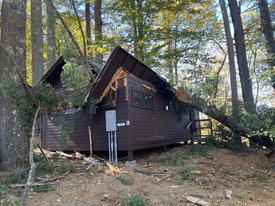 © Dan Dyer 2024 is built on the front and north end of Whitehead Hall.
© Dan Dyer 2024 is built on the front and north end of Whitehead Hall.
2. A giant pine tree behind the Taft Cabin comes down in an October windstorm, clips the corner of the Taft Cabin porch and completely smashes up one entire side of the Woofenden Cabin.
3. The FNCA becomes a full member of the Maine 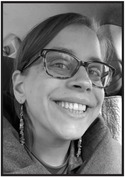 Association, offially cementing our position with the IRS as a church.
Association, offially cementing our position with the IRS as a church.
4. Emily Tergliafera elected as new Camp Director.
